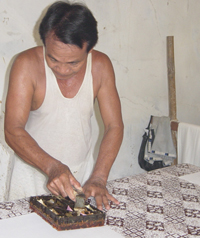BEST BATIK BUYS
Story and Pix by Geraldine Goh

Looking for quality batik in Southeast Asia? You can find some of the best designs in Indonesia.
In the small West Java town of Cirebon (pronounced as Chi-ray-born), located 260 kms away from the capital, Jakarta, you can see the finest artistry on display in the village of Trusmi.
Here, the cottage industry produces batik of exquisite quality with its fine craftsmanship on silk and cotton. The batik artists are mainly womenfolk who design the intricate motifs of this age-old traditional artform.
 The designs are first drawn on white cloth with pencil. If the background colour is to be black, for example then the other areas of the cloth are coated over with hot wax called “malam” to contain the spread of the black dye.
The designs are first drawn on white cloth with pencil. If the background colour is to be black, for example then the other areas of the cloth are coated over with hot wax called “malam” to contain the spread of the black dye.
When the waxing is completed, the cloth is dipped into the black dye and left to dry for a few hours. The wax is later removed by dipping the cloth into boiling water and again left to dry before a second layer of hot wax is coated onto areas that will not be dyed red, the second coloured layer in the batik design. The cloth is then dipped into the red dye and left to dry. The process is repeated by removing the old wax before another layer of hot wax is coated onto sections in the design which will not be dyed green, the third coloured layer in the batik production process. The area of the cloth that has been constantly covered by the hot wax will remain uncoloured.
 Batik painting is a painstaking process that could take up to two months to design a two-metre long scarf known as “selendang” and four months to produce a hand-painted cloth called “sarong”.
Batik painting is a painstaking process that could take up to two months to design a two-metre long scarf known as “selendang” and four months to produce a hand-painted cloth called “sarong”.
Batik printing is a much easier task as the waxing and colouring can be done much faster using metal plates with engraved designs.

The batik silk selendang costs US$20 and above, while a selendang and sarong set costs between US$50 and US$100, with the hand-painted ones priced much higher. The cotton products cost less than half the price.
How to get there:
Going to Cirebon by car will take you about seven hours because of the narrow roads and traffic jams. Be prepared also for the bumpy ride as there are many potholes along the way over this heavily used road, which serves as the one of the main intra-island transport routes.
You can also get to Cirebon by rail, which is a three-hour ride that will give you a glimpse of the green paddy fields and the ploughing and harvesting of paddy along the way.
Where to stay:
There is the comfortable four-star Hotel Santika, which costs less than US$40 a night including breakfast for a standard room.
The three-star Bentani Hotel has rooms for US$30 a night with breakfast.
